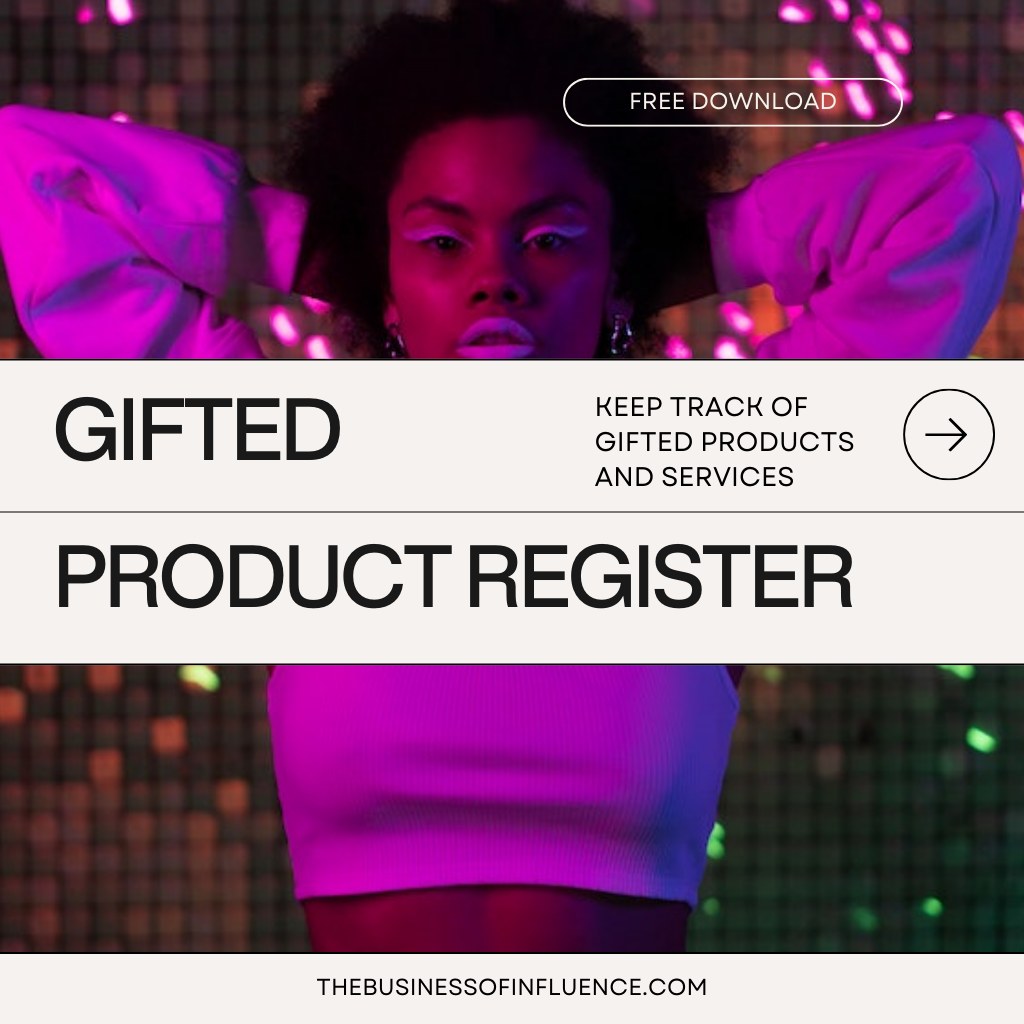A Guide to Gifted Campaigns for Influencers
Hey there, MOOTs. Picture this: you’re starting out, your audience is growing, and bam! You’re hit with your first gifted campaign. It’s not just a cool opportunity to snag freebies. No, it’s way more. It’s your personal brand’s proving ground, a place where your creativity and the brand’s message collide in a beautiful symphony. Well, that’s the aspirational goal anyway.
Think of gifted campaigns as a playground for storytelling, where you get to weave content that strikes a chord with both the brand you’re collaborating with and the awesome followers you’ve gathered. And hey, it’s also the perfect time to sharpen those negotiation skills. Discussions about expectations, content rights, and maybe even future gigs? All part of the game.
Gifted campaigns aren’t just a foot in the door; they’re a fully-fledged launch pad for your influencer career. As you gain more followers and carve out your niche, these campaigns become even more valuable. They might just transform from unpaid opportunities to something more.
But hold up, it’s not all sunshine and roses. There are some red flags you’ve got to watch out for in gifted campaigns. And what about the process you should follow when one lands in your lap? We’re unpacking all of this and more in the blog.
What are Gifted Campaigns?
Gifted campaigns are when brands provide influencers with free products or services in exchange for promotion or review via content posted on the influencer’s channels.
Unlike paid partnerships, where influencers receive payment for content creation, gifted campaigns rely on the value of the product or service itself as the payment. It’s not uncommon for influencers to have mismatch between the value of the product received and the deliverables requested by the brand. We’ll talk about this more a little later in the blog.
The process for your Gifted Influencer Campaign
These steps are taken directly from The Business Of Influence Campaign Pricing Framework. The process we follow for gifted influencer campaigns is very similar to paid campaigns. (Tip: listen to Episode 2 – Pricing Your Influencer Campaign)
🔍 Evaluating the Brand – Research the brand and product to ensure they align with your personal brand and audience interests. For example, if you’re a vegan recipe creator it would not be a good alignment to do a gifted campaign for eggs. A good alignment might be with a tofu, for instance.
Does the brand present any reputational risk for you, eg is it a gambling, tobacco or pharmaceutical brand?
What is the brand value? By that I mean is it a quality brand with a good reputation, or is it a brand that’s unknown, or worse still, has a dodgy reputation?
💡 Evaluating your Value – take a moment to think about the value you bring to the brand and the gifted campaign. Consider your audience size, your engagement rate, your audience demographics – do they align strongly with brand’s target market, their audience?
📊 Evaluate the Campaign:
- Communication – Has the flow of communication been easy and professional? An early insight to what you’ll experience working with the brand will come from the tone, timeliness, and professionalism of their communication (and yours!).
- Content Quality – The effort and resources required to create the content for the campaign should also be considered. We all want the content we produce to be reflective of our skills and our aesthetic but if the brand has too-high expectations around pre-and-post-production editing – that’s a red flag.
- Review the Brief – here we’re talking about the deliverables of the campaign – does the brand expect multiple pieces of content, across different platforms, are the key messages the brand wants you to convey clear, what usage rights are expected – think about does the brand plan to use your content for UGC in organic or paid content via their channels, do they want to boost the content on your channels, how long do they expect to have rights for, do they expect ownership of the content, and so on. If you’re unclear on any elements of understanding a campaign brief, we have a whole podcast episode on that –Brand Collaborations 101: Understanding the Brief.
🤝 Assess the Value Proposition: Consider the value of the product or service and weigh it against the effort required for the deliverables. How do you feel about producing the work that’s expected by the brand in exchange for the gifted product or service? Think about the actual price of the goods you’re being supplied and any other benefits you might be able to leverage from the campaign, eg building your portfolio, good brand association, you really want the product. Does it represent value for you and not just the brand?
🚩 Look for Red Flags
- Questionable Email Addresses or Communication Channels: If the approach comes from an email address that doesn’t match the brand’s official domain or through unprofessional communication channels, it could be a sign of a scam. Verifying the legitimacy of the brand contact is crucial. You can do this by cross-referencing the contact details with those on the brand’s official website or reaching out to the brand directly through their established channels to confirm the authenticity of the campaign offer. I constantly see messages in FB groups asking if an opportunity is a scam or not. Just do the legwork yourself first to confirm authenticity and if you can’t verify through a quick Google or social media search, it’s more than likely scam.
- Requirement to Pay for the Product: If a brand expects you to pay for the product they are offering, it is not a Gifted Campaign. It’s a sale for the brand.
- Paying for Postage or Other Hidden Costs: Being asked to cover postage or any hidden costs for receiving the gifted product.
- Request to Return the Product: A request to return the product after the promotion, which is not standard practice in genuine gifted campaigns.
- Excessive Deliverables for Low-Value Product: Expecting a high level of content creation or promotion in exchange for a product of minimal value.
- Lack of Clear Guidelines or Expectations: Vague or non-existent campaign guidelines, which can lead to misunderstandings and unmet expectations.
- Unnecessary Pre-Approval Requirements: A requirement to submit content for pre-approval can be excessive for gifted campaigns.
- Campaign Performance Reporting Requirements: While it’s standard to provide some feedback or basic metrics to the brand after a paid campaign you’re ok to decline this request on gifted campaigns.
- Pressure to Provide Unnaturally Positive Reviews: Pushing for overly positive reviews or not allowing honest opinions, which can compromise authenticity and audience trust.
- Demand for Rights to Your Content Without Payment: Insisting on full or partial rights to your content without offering fair payment or attribution.
- No Contract or Formal Agreement: Absence of a written agreement or contract, at the very least via email, outlining the terms of the campaign.
- Unethical or Misaligned Brand Practices: The brand has a history of unethical practices or values that don’t align with your own.
- Pressure to Hide the Sponsored Nature of the Post: Encouraging non-disclosure of the gifted nature of the campaign, which can lead to legal issues and a loss of audience trust.
📝 Negotiate Terms: If necessary, negotiate the terms of the campaign to ensure they are fair and mutually beneficial. Think about the red flags we just discussed as well as steps 1 – 4.
📸 Content Creation: Plan and create content that authentically integrates the product (or service) while resonating with your audience. Engage with your audience to support great engagement on the content.
🚀 Explore Future Opportunities: Post-campaign, consider the potential for ongoing collaborations with the brand. Reach out to express your interest in future paid opportunities or ask for referrals to other brands. Highlight positive outcomes from the campaign, such as great engagement, positive comments from your audience and how you enjoyed using the product/ service. This proactive approach may leverage a single gifted campaign into a paid campaign. Always ask! (Tip: Listen to 10 Tactics for Success as a Self-Managed Influencer)
🤔 Review and Reflect: After the campaign, reflect on its success and what you learned to apply to future campaigns. If the campaign has
Gifted campaigns can be more than just free products for influencers; they’re opportunities to build your skills and establish brand relationships. Managed well, these campaigns can lead to greater collaborations and can open doors to future paid opportunities, marking an important step in the growth of your career. Just remember, before accepting Gifted Campaigns, to follow a clear process to make sure you’re getting value from the experience.
Prefer to listen to this as a podcast? Jump on over to Ep 18: What Influencers Need to Know About Gifted Campaigns or search The Business Of Influence Gifted Campaigns on your preferred podcast platform.


